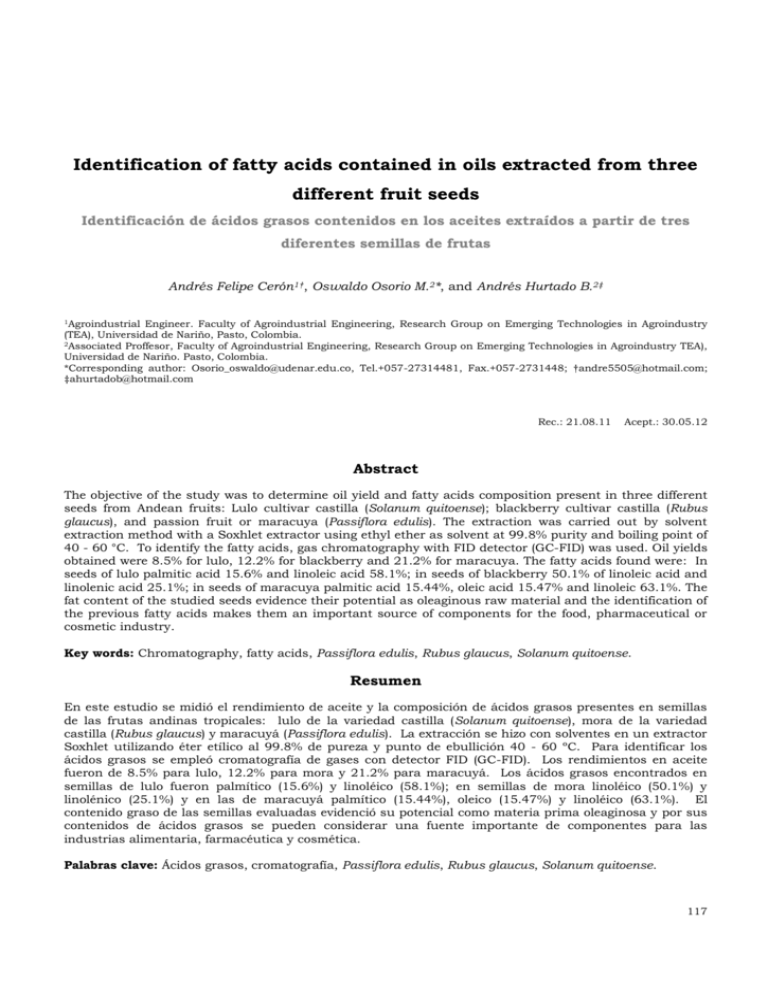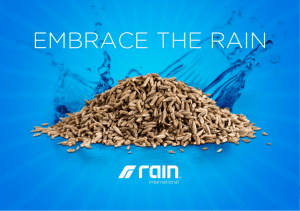
Identification of fatty acids contained in oils extracted from three
different fruit seeds
Identificación de ácidos grasos contenidos en los aceites extraídos a partir de tres
diferentes semillas de frutas
Andrés Felipe Cerón1†, Oswaldo Osorio M.2*, and Andrés Hurtado B.2‡
1Agroindustrial
Engineer. Faculty of Agroindustrial Engineering, Research Group on Emerging Technologies in Agroindustry
(TEA), Universidad de Nariño, Pasto, Colombia.
2Associated Proffesor, Faculty of Agroindustrial Engineering, Research Group on Emerging Technologies in Agroindustry TEA),
Universidad de Nariño. Pasto, Colombia.
*Corresponding author: Osorio_oswaldo@udenar.edu.co, Tel.+057-27314481, Fax.+057-2731448; †andre5505@hotmail.com;
‡ahurtadob@hotmail.com
Rec.: 21.08.11
Acept.: 30.05.12
Abstract
The objective of the study was to determine oil yield and fatty acids composition present in three different
seeds from Andean fruits: Lulo cultivar castilla (Solanum quitoense); blackberry cultivar castilla (Rubus
glaucus), and passion fruit or maracuya (Passiflora edulis). The extraction was carried out by solvent
extraction method with a Soxhlet extractor using ethyl ether as solvent at 99.8% purity and boiling point of
40 - 60 °C. To identify the fatty acids, gas chromatography with FID detector (GC-FID) was used. Oil yields
obtained were 8.5% for lulo, 12.2% for blackberry and 21.2% for maracuya. The fatty acids found were: In
seeds of lulo palmitic acid 15.6% and linoleic acid 58.1%; in seeds of blackberry 50.1% of linoleic acid and
linolenic acid 25.1%; in seeds of maracuya palmitic acid 15.44%, oleic acid 15.47% and linoleic 63.1%. The
fat content of the studied seeds evidence their potential as oleaginous raw material and the identification of
the previous fatty acids makes them an important source of components for the food, pharmaceutical or
cosmetic industry.
Key words: Chromatography, fatty acids, Passiflora edulis, Rubus glaucus, Solanum quitoense.
Resumen
En este estudio se midió el rendimiento de aceite y la composición de ácidos grasos presentes en semillas
de las frutas andinas tropicales: lulo de la variedad castilla (Solanum quitoense), mora de la variedad
castilla (Rubus glaucus) y maracuyá (Passiflora edulis). La extracción se hizo con solventes en un extractor
Soxhlet utilizando éter etílico al 99.8% de pureza y punto de ebullición 40 - 60 ºC. Para identificar los
ácidos grasos se empleó cromatografía de gases con detector FID (GC-FID). Los rendimientos en aceite
fueron de 8.5% para lulo, 12.2% para mora y 21.2% para maracuyá. Los ácidos grasos encontrados en
semillas de lulo fueron palmítico (15.6%) y linoléico (58.1%); en semillas de mora linoléico (50.1%) y
linolénico (25.1%) y en las de maracuyá palmítico (15.44%), oleico (15.47%) y linoléico (63.1%). El
contenido graso de las semillas evaluadas evidenció su potencial como materia prima oleaginosa y por sus
contenidos de ácidos grasos se pueden considerar una fuente importante de componentes para las
industrias alimentaria, farmacéutica y cosmética.
Palabras clave: Ácidos grasos, cromatografía, Passiflora edulis, Rubus glaucus, Solanum quitoense.
117
IDENTIFICATION OF FATTY ACIDS CONTAINED IN OILS EXTRACTED FROM THREE DIFFERENT FRUIT SEEDS
Introduction
Tropical andean fruit croops comprised especies with different developmental levels and
high potential for consumers acceptance.
Among them stand out blackberry (Rubus
glaucus Benth.), lulo (Solanum quitoense
Lam.) and some passiflora like passion fruit
(Passiflora edulis Sims) (Lobo, 2006).
Blackberry belongs to the rosaceae family,
fruit consist of an agglomerate of little purple
drupes joined to a conical receptacle that can
be easily separated from the plant; seed has a
kidney shape and its color varies from purple
to intense red (Vanarsdel, 1963). Lulo belongs to the Solanaceae family and to the Solanum genus which is the largest and diverse
(Bedoya and Barrero, 2009), fruit is ovoid with
yellow, orange or brown peel, covered by fine
spines or hair; internally, it is divided in four
compartments filled with greenish flesh and
numerous seeds (Schultes and Cuatrecasas,
1958). Passion fruit belongs to the Passifloraceae family and to the Passiflora genus, fruit
is a globose berry with rounded base and
apix; peel is yellow, dark, smooth and waxy;
contains 200-300 black or dark violet
seeds(García, 2002).
Nowadays these fruits have high demand
in juice and pulp industry (Lobo, 2006), that
is why they generate a large amount of residues which raw material is not well known
(Brennan et al., 1998). Among these residues
we have seeds that are characterized by their
high fiber content, mainly composed of cellulose, pectic substances and hemicellulose
(Basui, 1999), besides their wide variety of
components according to seed type and specific tissues (Stroshine and Hamann, 1993).
In Nariño, Colombia, is urgent to develop
techniques for using seeds coming from processed fruits, this in order to obtain oils for
pharmaceutical and cosmetic industries.
Boucher (1999) considers the urge to realize
and define research plans to use the richness
of autochthonous promissory products. Obtaining oils from residual seeds of processed
fruits is an agroindustrial alternative to give
value to this type of residue.
García et al. (2003) found oil and fat acids
residues in blackberry, and Ocampo et al.
(2007) found trygliceride from saturated and
unsaturated fats (linoleic, oleic, stearic and
118
linolenic) in soursop seeds, which represent a
potential for industrial use (Solis et al., 2010).
This work aimed to determine oil yield and
fat acids composition present in blackberry,
lulo and passion fruit, as an alternative for
agroindustrial development by using these
subproducts in food, pharmaceutical and
cosmetics industry.
Materials and methods
Location. This research was done in the Pilot
Plant of the Faculty of Agroindustrial Engineering in Universidad de Nariño, Torobajo,
Pasto, Nariño, located at 2527 MASL, with 14
°C average temperature and 70% relative humidity.
Raw material. 1 kg seed samples of lulo
(Solanum quitoense) cv. Castilla, blackberry
(Rubus glaucus Benth) cv. Castilla and passion fruit (Passiflora edulis) were used. They
were supplied by Inpadena factory in Pasto
that is dedicated to pulp extraction of these
fruits.
Processing. Initially, pulp excess adhered to
seeds was removed; for that, seeds were
washed with tap water and at the same time
empty seeds were eliminated.
After that,
seeds were dyed out in trays at 60 °C with 20
m/s air speed for 8 h. Finally, dried seeds
were passed through hammermill (Hsiao Lin
Machine model 61060), by a sieve (PS-35 series 1182) and by a sieve series 10-30,
A.S.T.M.E. for 5 min.
Oil extraction. For oil extraction 15.00 ±
0.01 g of seeds of each fruit were processed
with particle diameter between 0.5943 and
0.8407 cm. For this, a Soxhlet extractor was
used, ethyl eter (99.8%) was used as solvent
and boiling point was between 40 and 60 °C
(Bernal, 1998) with 8h reflux. Solvent recovery was done by distillation on a rotatory
evaporator (Eyela Oil Bath OSB-2000). Extract was dried out at 60 ± 2 ºC on electrical
oven (Thermolab Dies) for 30 min until residual solvent was evaporated, it was cooled
down and weighted to determine yield. Finally, the obtained oil was conserved in vials
(amber glass bottles with screw cap).
Humidity determination.
To determine
sample humidity, 2.00 ± 0.01 g of samples
were weighted and heated at 100 °C on electrical oven (Thermolab Dies) during 24 h until
ACTA AGRONÓMICA. 61 (2) 2012, p 117-123
a constant weight was reached, then their dry
weight was determined (Less, 1998).
Sample weight, yield determination and
humidity were done on analytical balance
Precisa 310M 3000 g and ± 0.01 g precision
Fatty acids determination. To prepare the
samples the derivatization method was used
in the specialized lab at the Universidad de
Nariño, which is based on the trans-esterification catalyzed with acid technique. 200 μl
of each oil were extracted, 1 ml of hexane
HPLC grade was added, then 10 ml of 5% HCl
in CH3OH were prepared. This solution together with the samples were in reflux for 2 h
at 70 °C; then 5 ml distillated water were
added and left to stand for 10 min; 2 ml of
hexane HPLC grade were added to separate
the sample on a special funnel.
Analytical procedures. Fatty acids analysis
on seeds was done using a gas chromatographer Shimadzu GC-17.A, with a Supelcowax
column (30m x 0.25mm ID 0.25μm) and a
FID detector at 280 °C. Injection mode: split,
rate 20:1, flux 1.0 ml/min, injector temperature 250 °C; Temperatures programmed in
column: 40 °C till 130 °C at 15°C per minute,
then incremented to 240 °C (10 min) at 30 °C
per minute, finally incremented to 250 °C at
10 °C per minute.
Fatty acids metyl sters standards were
used for respective comparisons, including
retention indexes for those components not
identified by standard chromatography. Experimental design was totally randomized,
measurements were done by triplicate and
results are shown as average values.
Results and discussion
Oil yield
The lowest humidity contents and highest oil
percentages were found in passion fruit seeds,
followed by blackberry seeds (Table 1). In this
study the fatty acids value was higher than
the one (9.2%) obtained by García et al.
(2003). According to the fat percentage in the
evaluated seeds is possible to predict its
higher potential as oilseeds for food, pharmaceutical and cosmetic industry, which are
high consumers of vegetable oils.
Fatty acids identification
In the analyzed samples there were found the
corresponding ‘picks’ to fatty acids metyl ster
standards at different retention times, identifying the following: palmitic, stearic, oleic,
linoleic and linolenic acids in the three types
of seeds (Figure 1). Palmitoleic acid is only in
lulo (Solanum quitoense) seeds (Table 2).
Chromatograms show six signals in Solanum
quitoense oil (Figure 2), and five signals in
Rubus glaucus Benth (Figure 3) and in Passiflora edulis (Figure 4). Analysis of each pick
in the chromatogram showed the fatty acids
present in each type of seeds (Table 2). Results allow the comparison of oils based on
their composition by fatty acids percentage,
which was different (P < 0.05) between the
seeds of the different fruits. It is important to
notice the presence of palmitoleic in Solanum
quitoense seeds.
The most abundant fatty acid in seeds was
Table 1. Oil yield in tropical fruits seeds.
Fruit
Humidity*
(%)
Yield
(% oil)
Average
(% oil)
Standar
deviation
CV
(%)
Blackberry
6.137
12.321
11.683
12.634
12. 213
0.484
3.962
Passion
fruit
5.051
19.630
21.460
22.545
21.212
1.473
6.945
Lulo
6.760
7.762
9.030
8.842
8.545
0.684
8.008
* Average of three samples/fruit.
119
IDENTIFICATION OF FATTY ACIDS CONTAINED IN OILS EXTRACTED FROM THREE DIFFERENT FRUIT SEEDS
Figure 1. General chromatogram of methyl ster fatty acids (standard 99.98%).
1, 2, 3 N.I., 4 Undecanoic, 5 Dodecanoic acid, 7 Palmitic, 8 Palmitoleic, 9 Oleic,
10 Linoleic, 11 Linolenic
Figure 2. General chromatogram of a lulo (Solanum quitoense) seed oil sample.
1 Palmitic, 2 Pamitoleic, 3 Stearic, 4 Oleic, 5 Linoleic, 6 Linolenic.
Figure 3. General chromatogram of blackberry mora (Rubus glaucus) seed oil sample.
1 Palmitic, 2 Stearic, 3 Oleic, 4 Linoleic, 5 Linolenic.
120
ACTA AGRONÓMICA. 61 (2) 2012, p 117-123
Figure 4. General chromatogram of a passion fruit (Passiflora edulis) seed oil sample.
1 Palmitic, 2 Stearic, 3 Oleic, 4 Linoleic, 5 Linolenic.
Table 2. Fatty acids in tropical fruit seeds.
Fruit
‘picks’
number
1
Retention time
(min)
13.641
Acid type
*Percentage
Palmitic ME
15.6 a
Blackberry
1
13.660
Palmitic ME
Passion fruit
1
13.674
Palmitic ME
15.44 c
Lulo
2
13.891
Palmitoleic ME
2.35
Blackberry
-
-
-
-
Passion fruit
-
-
-
-
Lulo
3
15.591
Stearic ME
3.65 a
Blackberry
2
15.616
Estearico ME
4.11 b
Passion fruit
2
15.632
Estearico ME
Lulo
4
15.924
Oleic ME
14.00 a
Blackberry
3
15.940
Oleic ME
9.42 b
Passion fruit
3
15.960
Oleic ME
15.47 c
Lulo
5
16.582
Linoleic ME
58.10 a
Blackberry
4
16.610
Linoleic ME
50.1 b
Passion fruit
4
16.624
Linoleic ME
63.1 c
Lulo
6
17.600
Linolenic ME
6.21 a
Blackberry
5
17.624
Linolenic ME
Passion fruit
5
17.650
Linolenic ME
Lulo
11.24 b
3.00 c
25.1 b
1.10 c
*Average values for three observations.
*For each percentage, no common letters mean differences between averages according to the LSD Fisher´s test at 95%
confidence.
the linoleic in concentrations > 50%. This
acid is essential for humans since they lack of
enzymes needed to insert double bounds in
carbon atoms that are further than carbon 9.
(Ronayne de Ferrer, 2000; Sanhueza et al.,
2002; Galgani, 2004; Tapia, 2005), and its
121
IDENTIFICATION OF FATTY ACIDS CONTAINED IN OILS EXTRACTED FROM THREE DIFFERENT FRUIT SEEDS
importance lies primarly in its role as precursor for long fatty acids chains, like arachidonic acid, this characterized the acid as
essential for food metabolism (Simopoulos,
1991; Peterson et al., 2006).
According to Pariza (1999) poly-insaturated fatty acids (linolenic and linoleic) have
nutraceutical ingredients that are essential
for growth and good state of skin and hair
(Ziller, 1994). These and the other oils identified in the fruits studied in this research,
have different industrial uses like oleic acid in
cosmetic formulas and in mixtures with mineral oils (Martini, 2005), and palmitic acid as
consistency factor or to acidify emulsions
(Martini, 2005). Linoleic acid participates in
prostaglandins synthesis, in membrane generation and, in other biological processes related to cellular regeneration (Moreno, 1990).
Linoleic, oleic and linolenic acids are emollient components commonly used in cosmetics and dermopharmacy (Benaiges, 2008).
Conclusions
Average oil yield in lulo seeds was 8.545&,
in blackberry 12.213% and in passion
fruit 21.212%. Fatty acids content in
these seeds show their potential as oilseed
raw material for industry based on vegetable oils, this gives extra value to this type
of residues from pulp and juice industry.
Common fatty acids present in seeds of
these fruits were palmitic, stearic, oleic,
linoleic and linolenic acids; palmitoleic
acid appears as different fatty acid.
Identification of the previous fatty acids
makes the seeds of these fruits an important source of useful component for
food, pharmaceutical and cosmetic industry.
The fatty acids proportions found suggest
the performance of new studies on purification and fractionation due to the high
potential of lulo (Solanum quitoense),
blackberry (Rubus glaucus Benth) and
passion fruit (Passiflora edulis) seeds.
References
Badui, S. 1999. Química de los alimentos, 3ra ed.,
Editorial Adisson wesley Logman de México S.A. de
C.V., México D.F., México.
122
Bedoya, R. O. and Barrero, L. 2009. Filogenia de lulo,
tomate de árbol y sus parientes silvestres. Cienc.
Tecnol. Agrop. 102:180 - 190.
Benaiges, A. 2008. Aceite de rosa mosqueta:
composición y aplicaciones dermocosméticas.
Offarm. 27(6):94 - 97.
Bernal, I. 1998. Análisis de Alimentos., 3ra ed.,
Editora Guadalupe Ltda., Santafé de Bogotá. 48 p.
Boucher, F. 1999. Congreso Nacional de Ciencias y
Tecnología de Alimentos. Lima, Centro Regional
Andino. 1999-05-11/1999-05-14. Santafé de
Bogotá, Colombia. 16 p.
Brennan, J.; Butters, J.; Cowell, N.; and Lilley, A.
1998. Las operaciones de la ingeniería de los
alimentos, 3ra. Ed. Editorial Acribia S.A., Zaragoza,
España.
Galgani, E. 2004. Evaluación de la situación de
ácidos grasos esenciales y derivados de cadena
larga en la dieta de lactantes menores de un año.
Rev. chil. nutr. 31(1): 154 - 160.
García, D.; Viloria, A.; Belén, D.; and Moreno, M.
2003. Características físico-químicas y composición
de ácidos grasos del aceite crudo extraído de
residuos de mora Rubus glaucus Benth. Grasas y
Aceites 54(4): 259 - 263.
García, T. M. 2002. Cultivo de maracuyá amarillo.
Guía Técnica. Centro Nacional de Tecnología
Agropecuaria y Forestal. Arce, El Salvador. p. 12.
Less, R. 1988. Análisis de los Alimentos., 2ª ed., Ed.
Acribia., Madrid.
Lobo, A. M. 2006. Recursos genéticos y mejoramiento
de frutales andinos: una visión conceptual. En:
Revista
Corpoica
–
Ciencia
y
Tecnología
Agropecuaria 72: 40 - 54.
Martini, M. 2005. Introducción a la dermofarmacia y
a la cosmetología. Ed, Acribia S.A., Zaragoza
España. 300 p.
Moreno, J.; Bueno, J.; Navas, J.; and Camacho, F.
1990. Tratamiento de las úlceras cutáneas con
aceite de rosa mosqueta. Med. Cut. p. 63 - 66.
Ocampo, D.; Betancur, L.; Ortiz, A.; and Ocampo, R.
2007. Estudio cromatográfico comparativo de los
ácidos grasos presentes en semilla de Annona
cherimolioides y Annona muricata L. Vector 2:103 112.
Pariza, M. W. 1999. The biological activities of
conjugated linoleic acid. En: M. P. Yurawecz et al.
(eds.).
Advances in conjugated linoleic acid
research. Am. Oil. Chem. Soc. Press, Champaign IL.
p. 12 - 20.
Peterson, G.; Aguilar, D.; Espeche, M.; Mesa, M.;
Jáuregui, P.; Díaz, H.; Simi, M.; and Tavella, M.
2006. Acidos grasos trans en alimentos consumidos
habitualmente por los jóvenes en Argentina. Rev.
Chil. Ped. 77(1).
Ronayne de Ferrer, P. 2000. Importancia de los
ácidos grasos poliinsaturados en la alimentación
del lactante. Arch Argent Ped. 98:231 - 238.
Sanhueza, J.; Nieto, S.; and Valenzuela, A. 2002.
Ácido linoleico conjugado: un ácido graso con
isomeria trans potencialmente beneficioso. Rev.
chil. nutr. 29(2): 98 - 105.
ACTA AGRONÓMICA. 61 (2) 2012, p 117-123
Schultes, H. y Cuatrecasas, J. 1958. Notes on the
cultivated lulo. Harvard Univ. Bot. Museum Leaflets
16(5):97 - 105.
Simopoulos, A. 1991.Omega-3 fatty acids in health
and disease and in growth and development. Am. J.
Clin. Nutr. 54:438 - 463.
Solis, J.; Amador, C.; Hernandez, M.; and Duran, M.
2010.
Caracterización
fisicoquímica
y
comportamiento térmico del aceite de almendra de
guanábana Annona muricata L. Grasa y Aceites
61(1): 58 - 66.
Stroshine, R. and Hamann, D. 1993. Physical
properties of agricultural materials and food
products, Copyright by Richard Stroshine all rights
reserved. Department of Agricultural and Biological
Engineering Purdue University Wes Lafayette,
Indiana. Pp. 61.
Tapia, A. E. 2005. La suplementación con ácidos
grasos omega-3 disminuye la agresividad,
hostilidad y el comportamiento antisocial. Rev. chil.
nutr. 32(2): 95 - 101.
Vanarsdel, W. 1963. B.S..Food dehydratation,
volumen 1. The AVI publishing company, Inc.,
Connecticut, USA.
Ziller, S. 1994. Grasas y aceites alimentarios., 7a ed.,
Ed. Acribia, S.A., Zaragoza España. Pp. 13.
123








